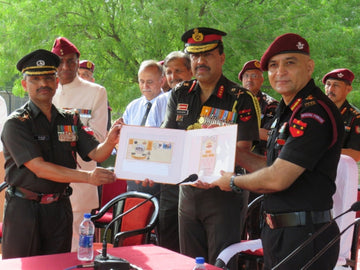Articles
50 Positive Word Association Test (WAT) Examples
by Olive Squad
on
Jun 19, 2025
The Word Association Test (WAT) is a psychological evaluation method used extensively in various selection processes, particularly in military and defence services. It helps assess a candidate’s thought processes, psychological disposition, and intrinsic values through their immediate reactions to a set of words. The test is designed to provoke spontaneous associations, revealing underlying attitudes and beliefs. In the context of Services Selection Board (SSB) interviews, where a candidate's mindset plays a critical role, a positive word association can make a significant difference in evaluations.
Navigating the WAT effectively can be essential for candidates aiming to showcase their skills, values, and preparedness for leadership roles. Thus, a well-rounded understanding of the key positive associations is critical. This article elucidates 50 positive word association examples, grouped into meaningful themes, some of which highlight Leadership and Teamwork, Personal Growth and Development, Positive Traits and Values, Emotional and Psychological Well-being, and Motivation and Ambition.
Leadership and Teamwork
In the realm of leadership, the way individuals perceive and respond to words associated with team dynamics can shine a light on their potential effectiveness as leaders.
-
Leader: Inspires action, captures the respect of peers, and is pivotal in guiding teams through challenges. Good leaders are those who motivate their teams to achieve set objectives through encouragement and vision.
-
Teamwork: Collective achievement through synergy. It emphasizes unity of purpose, where diverse skills collaborate towards a shared goal, enhancing overall performance.
-
Cooperate: Communicates the idea of working harmoniously with others. It reinforces a philosophy that success is not solely individual but shared among a collective where each member's strengths contribute to the overall success.
-
Mentor: A figure that embodies guidance and support, fostering growth in others. Mentorship programs can be instrumental in professional development, showcasing the importance of leadership that empowers.
-
Vision: Represents the foresight necessary for effective leadership. A leader with vision has the ability to chart a clear path forward, inspiring others to follow and believe in the possibilities of tomorrow.
Personal Growth and Development
Personal growth is a lifelong journey that often requires overcoming challenges and reflecting on experiences.
-
Challenge: Viewed as an opportunity for growth, challenges help develop resilience. Individuals who embrace challenges often demonstrate a commitment to personal development and adaptive learning.
-
Failure: A learning experience that, while often viewed negatively, can be reframed as a stepping stone to success. Embracing failure enables personal growth and offers valuable lessons that fuel future achievements.
-
Discipline: Represents steadfast commitment. Those who practice discipline reveal a strong work ethic and the ability to prioritize tasks effectively to reach goals.
-
Determination: The unyielding resolve to persist, even in the face of adversity. Determined individuals are often champions for change and transformation in any environment they operate in.
-
Progress: Continuous improvement is the essence of personal development. Progress is not merely about reaching destinations but appreciating the journey of growth that shapes one's character and abilities.
Positive Traits and Values
Highlighting positive traits and values can be instrumental in shaping personal identity and defining interpersonal relationships.
-
Honesty: The foundation of trust. An honest individual fosters open communication, ensuring relationships built on transparency and reliability.
-
Respect: Earned recognition that reflects the value one places on others. Respect promotes harmony and understanding in relationships, essential in both personal and professional contexts.
-
Integrity: Adherence to moral principles and values creates a strong personal brand. Integrity ensures consistency between one’s words and actions, fostering authenticity.
-
Courage: The ability to act despite uncertainty. Courageous individuals often take risks, stand up for their beliefs, and inspire others by leading through action.
-
Empathy: Understanding and appreciating others' feelings fosters deep connections. Empathetic individuals often find themselves in leadership roles, as they understand the importance of emotional intelligence.
Emotional and Psychological Well-being
Fostering emotional and psychological well-being is critical in today’s fast-paced environment, where stress and challenges abound.
-
Joy: Represents an experience of inner fulfillment. Individuals who find joy in their activities often motivate those around them through their positive outlook.
-
Peace: A state of internal harmony that is crucial for effective stress management. Individuals who cultivate peace often exhibit better decision-making abilities and a sense of calm in chaotic situations.
-
Happiness: Present contentment is a vital component of well-being. Happiness leads to improved performance, greater resilience, and a positive influence on others.
-
Love: Deep, selfless devotion humanizes the modern workplace. Understanding love as a driving force can lead to more compassionate leadership styles and cohesive teams.
-
Contentment: Satisfaction with one’s situation helps mitigate dissatisfaction. Content individuals tend to inspire those around them to focus on gratitude, ultimately influencing workplace morale positively.
Motivation and Ambition
Motivation and ambition drive individuals to pursue goals and reach their full potential, often determining their level of success.
-
Ambition: Directed aspiration towards goals indicates a proactive mindset. Ambitious individuals are often viewed as leaders due to their drive to achieve, motivating others near them.
-
Motivation: The inner drive to succeed manifests in various forms. Individuals with intrinsic motivation tend to be more committed and enthusiastic about their tasks, leading to higher performance levels.
-
Passion: Strong enthusiasm for pursuits ignites creativity and dedication. Passionate individuals are often willing to invest the necessary time and resources to achieve their aims.
-
Success: The achievement of aspirations is celebrated across cultures. Defining success varies among individuals, but the pursuit remains a common thread that binds people together.
-
Goals: Clear targets for achievement shape how individuals and organizations function. Effective goal-setting can enhance focus and accountability, thus optimizing performance.
Preparing for the Word Association Test
Understanding the significance of these positive associations allows candidates to approach the WAT with confidence. Preparation should involve familiarizing oneself not only with the words but also with their context and potential responses. Here are strategies for effective preparation:
-
Study Examples: Review the 50 positive association words and their meanings. Understand how they can influence perception during the WAT.
-
Practice With Friends: Engage in mock WATs with teammates or mentors. Receiving feedback can enhance your ability to articulate your thoughts.
-
Develop a Repertoire: Create a range of positive associations for each term. Be ready to adapt your responses depending on the specific context in which the word is presented.
Case Studies or Real-world Applications
The WAT is utilized effectively within the selection processes of various organizations, particularly in the military and corporate world. Take, for instance,
SSBCrack's preparation courses, which are strategically crafted to help candidates excel in such psychological evaluations. By incorporating real-world scenarios and feedback from past candidates, participants can explore practical applications of WAT principles, enhancing comprehension of their inherent skills and abilities.
Statistical Data and Research Insights
Research indicates that individuals with high emotional intelligence—often connected to positive word associations—tend to excel in leadership and team roles. According to a study published in the
Journal of Organizational Behavior, leaders with strong emotional intelligence significantly outperform their peers in effective leadership capabilities. Furthermore, data from various psychological evaluations underscores that optimistic outlooks lead to improved performance metrics in workplace environments—an essential consideration in the context of the WAT.
Challenges and Solutions
Candidates preparing for the WAT may confront several challenges:
-
Nervousness: Anxiety can impede performance during assessments. Engaging in mindfulness techniques, such as visualization or meditation, can enhance focus and calm nerves.
-
Misinterpretation of Words: Ambiguous words could lead to negative associations. Candidates should familiarize themselves with the softer, positive connotations that words may carry.
-
Connecting Personal Experiences: Sometimes, individuals struggle to find immediate personal associations. Through journaling and reflection, candidates can align their experiences with the WAT’s positive themes.
Future Trends and Predictions
As assessments like the WAT evolve, integrating technology may refine how these evaluations are conducted. Virtual reality and simulation-based assessments might offer deeper insights into candidates’ emotional reactions. Alongside traditional assessments, this technological shift could enhance the breadth of understanding human behavior and personality effectively in high-stakes environments.
Conclusion
The Word Association Test serves as a profound indicator of an individual's psychological disposition, emotional intelligence, and leadership potential. Candidates aiming to succeed in their respective fields must prepare adequately by familiarizing themselves with key positive associations. The 50 word examples explored in this article—ranging from leadership to personal growth, motivations, and emotional well-being—are crucial for framing responses effectively during assessments.
The journey of preparation involves more than mere memorization; it demands introspection and an understanding of how one’s own experiences and attributes can contribute towards positive answers. Engaging with the inherent values outlined in this article can ultimately guide candidates through selection processes, such as those facilitated by
SSBCrack, leading them to success in their pursuits. As we move forward, it becomes increasingly evident that the values encapsulated in the WAT not only shape careers but also enhance one’s personal growth journey.
With this knowledge at your disposal, approach your WAT with confidence, and remember: your mindset holds the key to unlocking your potential in any high-stakes environment.





